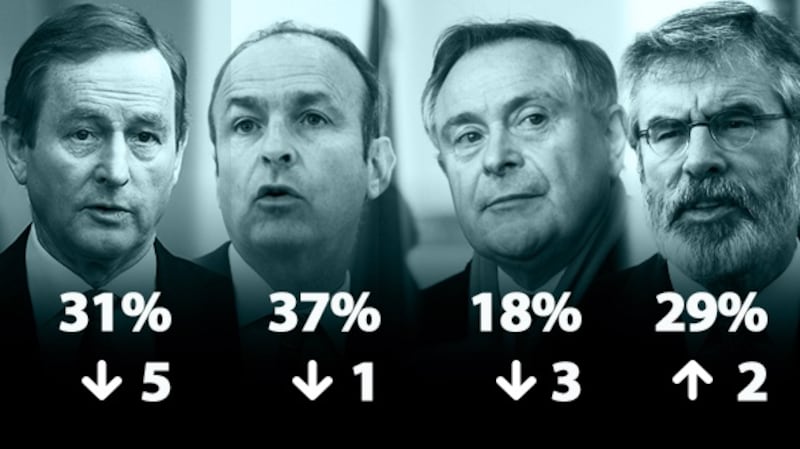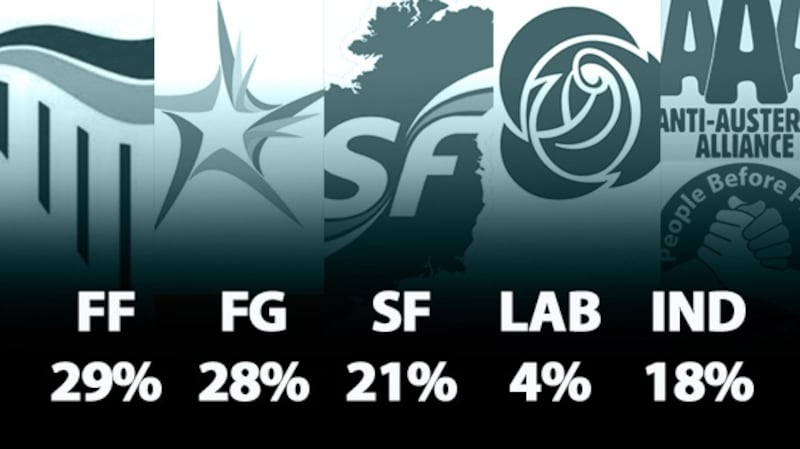In recent weeks the Government has been brought to the brink of collapse by its inept handling of an alleged scandalous abuse of power in An Garda Síochána.
Enda Kenny has been forced to indicate he will depart in the coming weeks, calling time on a long and eventful 15 years as leader of Fine Gael, six of them as Taoiseach.
Yet the impact on the overall political landscape is marginal. Yes, satisfaction with the Government has fallen by six points today, down from 34 per cent in December to 28 per cent today. The Taoiseach’s own satisfaction rating is down five points, from 36 per cent to 31 per cent.

But the alpha and omega of the polling numbers – the relative strengths of the parties’ votes – have not changed much.
Support for both big parties shifts a notch – Fianna Fáil a point down, Fine Gael a point up, both inside the margin of error.
It leaves the two parties almost in a dead heat – 29 per cent against 28 per cent. It will soothe nerves a little in Fine Gael, which had feared that a sporadic Fianna Fáil lead in the polls would prompt Micheál Martin to engineer an opportunistic general election.
The recovery of Fianna Fáil over the medium term is significant: today’s 29 per cent is among its best results since the party’s numbers fell off a cliff in 2008-09. Martin is again the most popular party leader. But on today’s numbers there is no incentive for the Fianna Fáil leader in pulling the election manoeuvre right now.

Healthy lead
Fine Gael has a healthy lead over its rivals in Dublin, where it has 29 per cent support compared with 23 per cent for Fianna Fáil. Regional breakdowns are based on a smaller sample than the full poll, and should be best treated as indicative rather than absolute numbers, but the Fine Gael lead was also evident in the December poll.
Fianna Fáil is ahead in the rest of Leinster outside Dublin (29 per cent to 26 per cent) and by a whopping 39 per cent to 22 per cent in Connacht-Ulster, while Fine Gael leads in Munster by 33 per cent to 29 per cent.
The Fine Gael advantage in Dublin is most likely related to its strong lead among the wealthiest AB section of the electorate, where Fine Gael enjoys 41 per cent against Fianna Fáil’s 21 per cent.
That balance is reversed among working class C2 and DE voters, where Fianna Fáil enjoys a clear advantage.
Medium-term trend
The important thing to look for in the polls is the medium-term trend, and Fianna Fáil’s medium-term trend is one of recovery. On the evidence of today’s poll, and the one before that – and the one before that too – Fianna Fáil is not leaving Fine Gael in its wake. The big parties are locked together in the late 20s; both a bit ahead of where they were at the general election 12 months ago.
Sinn Féin rises to 21 per cent today, a four-point jump since the December poll. Gerry Adams is the only party leader to increase his satisfaction rating, albeit by a marginal two points.
The party has been on a steady upward trend since the general election (when it won 14 per cent of the vote) but we know that the party tends to undershoot – often substantially – its pre-election polls. That is probably because – as today’s poll again illustrates – Sinn Féin’s support is heavily skewed towards younger voters (32 per cent among the under-34s) and the least wealthy groups (31 per cent among the lowest income DE group). These are exactly the people least likely to turn out on election day.
Difficulties
Measuring and analysing the vote of Independents and small parties always encounters difficulties. The vote is so fractured that the samples are invariably small, and movements invariably within the margin of error. Indeed, the national figure is normally within the margin of error.
So in today’s Independents/others figure of 18 per cent, the others are Greens (3 per cent), Anti-Austerity Alliance-People Before Profit (3 per cent), Social Democrats (1 per cent).
The Independents comprise of the Independent Alliance (2 per cent), Independents 4 Change (2 per cent), “other grouping” (2 per cent), “not a member of any group” (4 per cent), and 1 per cent who refused to say or did not know if their preferred Independent candidate was a member of any group.
Labour is not yet counted among the "others" but on the evidence of today that day may not be far off. The party is at 4 per cent, down two points, and down three since its disastrous general election last year. Brendan Howlin's satisfaction rating falls to 18 per cent, and to just 35 per cent among his own party's voters. There is no sign of a recovery in Dublin, where Labour is at 5 per cent. That's pretty close to flatlining.
Big national polls are not the best mechanism for measuring the smaller parties. Their fortunes depend on having strong candidates in a smallish number of constituencies, and that individual localised strength does not necessarily show up in national polls. However, the national picture cannot be totally contradicted by local trends, and if there are reasons for Labour not to panic there are also undoubtedly grounds for worry.













